MIT608 Strategic ICT Implementation Plan for Information Systems
VerifiedAdded on 2023/05/29
|12
|2709
|121
Report
AI Summary
This report provides an analysis of strategic Information and Communication Technology (ICT) implementation plans, emphasizing their significance in modern organizations. It begins by outlining strategic ICT implementation plans adopted by various organizations, highlighting their objectives such as waste reduction, creation of common ICT infrastructure, and utilizing ICT for organizational changes. A comparative analysis identifies similarities and differences between these plans, focusing on technology use, change enablement, and governance. The report further appraises factors affecting successful ICT implementation, including organizational, operational, structural, and technological considerations. An evaluation of findings leads to a proposed strategy centered on aligning business operations and enhancing communication, with a critical justification for its potential to ensure successful implementation. The report concludes by reiterating the importance of ICT in strategic urbanization, emphasizing its role in enabling users to access, transmit, manipulate, and store confidential information.
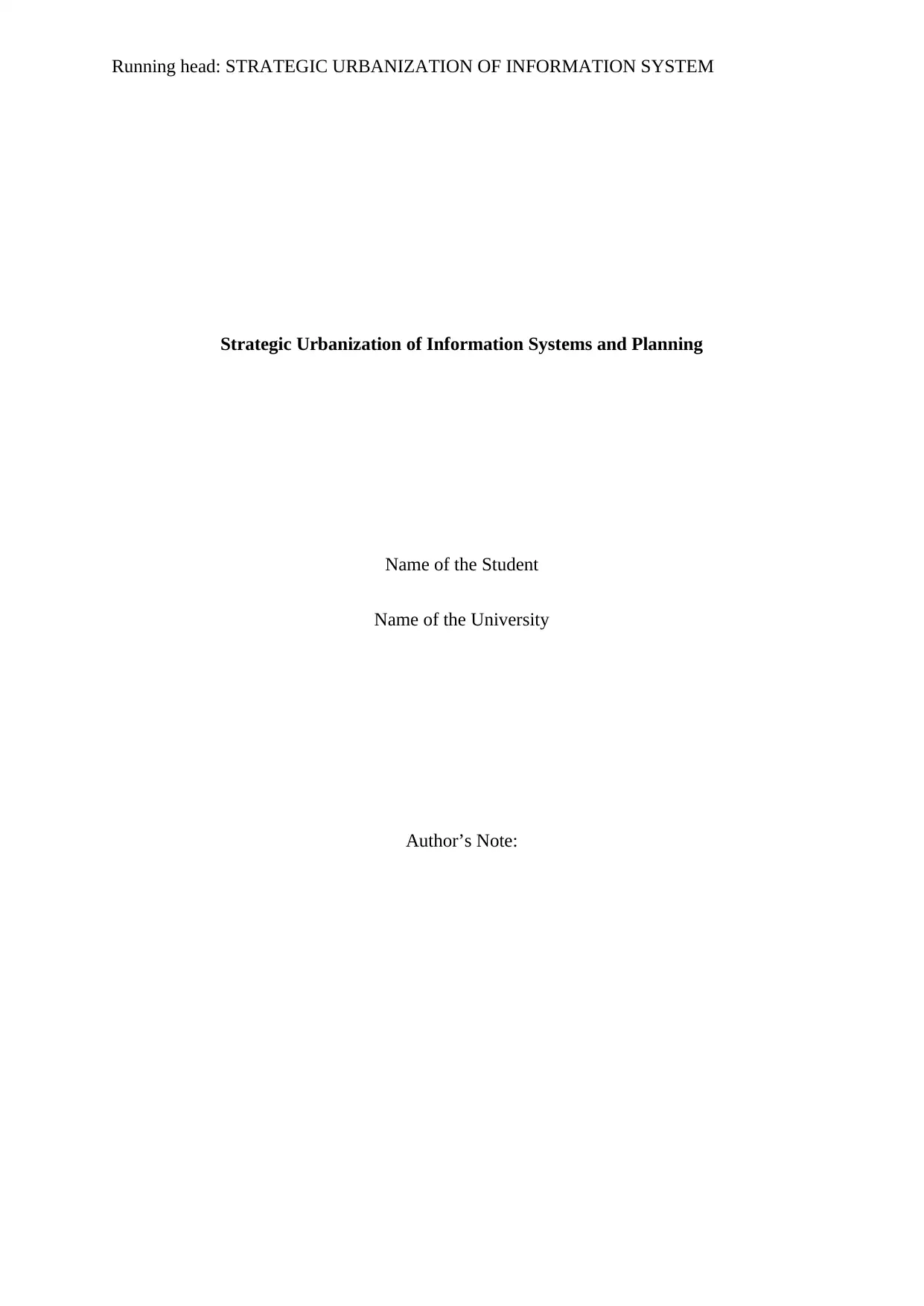
Running head: STRATEGIC URBANIZATION OF INFORMATION SYSTEM
Strategic Urbanization of Information Systems and Planning
Name of the Student
Name of the University
Author’s Note:
Strategic Urbanization of Information Systems and Planning
Name of the Student
Name of the University
Author’s Note:
Paraphrase This Document
Need a fresh take? Get an instant paraphrase of this document with our AI Paraphraser
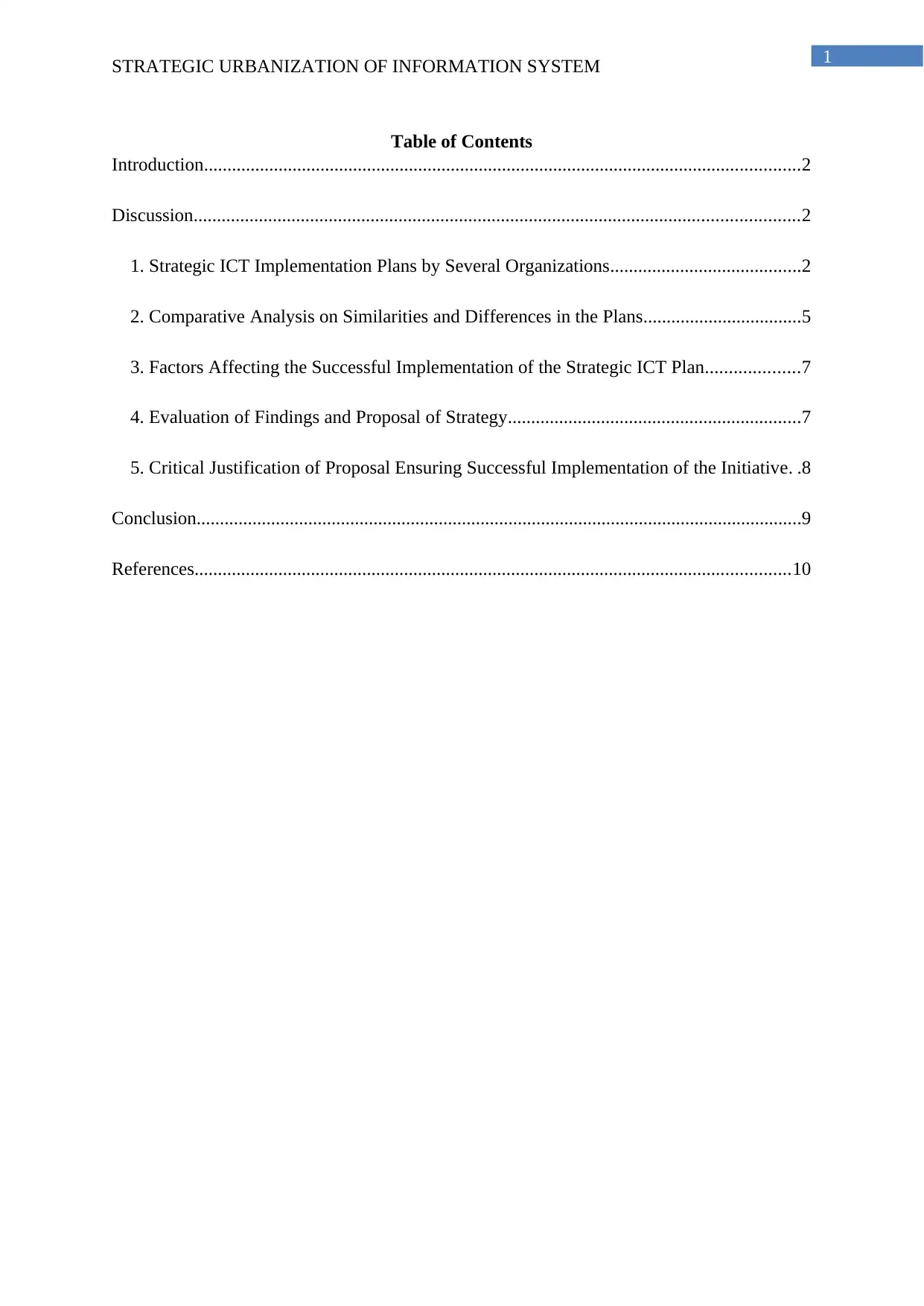
1
STRATEGIC URBANIZATION OF INFORMATION SYSTEM
Table of Contents
Introduction................................................................................................................................2
Discussion..................................................................................................................................2
1. Strategic ICT Implementation Plans by Several Organizations.........................................2
2. Comparative Analysis on Similarities and Differences in the Plans..................................5
3. Factors Affecting the Successful Implementation of the Strategic ICT Plan....................7
4. Evaluation of Findings and Proposal of Strategy...............................................................7
5. Critical Justification of Proposal Ensuring Successful Implementation of the Initiative. .8
Conclusion..................................................................................................................................9
References................................................................................................................................10
STRATEGIC URBANIZATION OF INFORMATION SYSTEM
Table of Contents
Introduction................................................................................................................................2
Discussion..................................................................................................................................2
1. Strategic ICT Implementation Plans by Several Organizations.........................................2
2. Comparative Analysis on Similarities and Differences in the Plans..................................5
3. Factors Affecting the Successful Implementation of the Strategic ICT Plan....................7
4. Evaluation of Findings and Proposal of Strategy...............................................................7
5. Critical Justification of Proposal Ensuring Successful Implementation of the Initiative. .8
Conclusion..................................................................................................................................9
References................................................................................................................................10
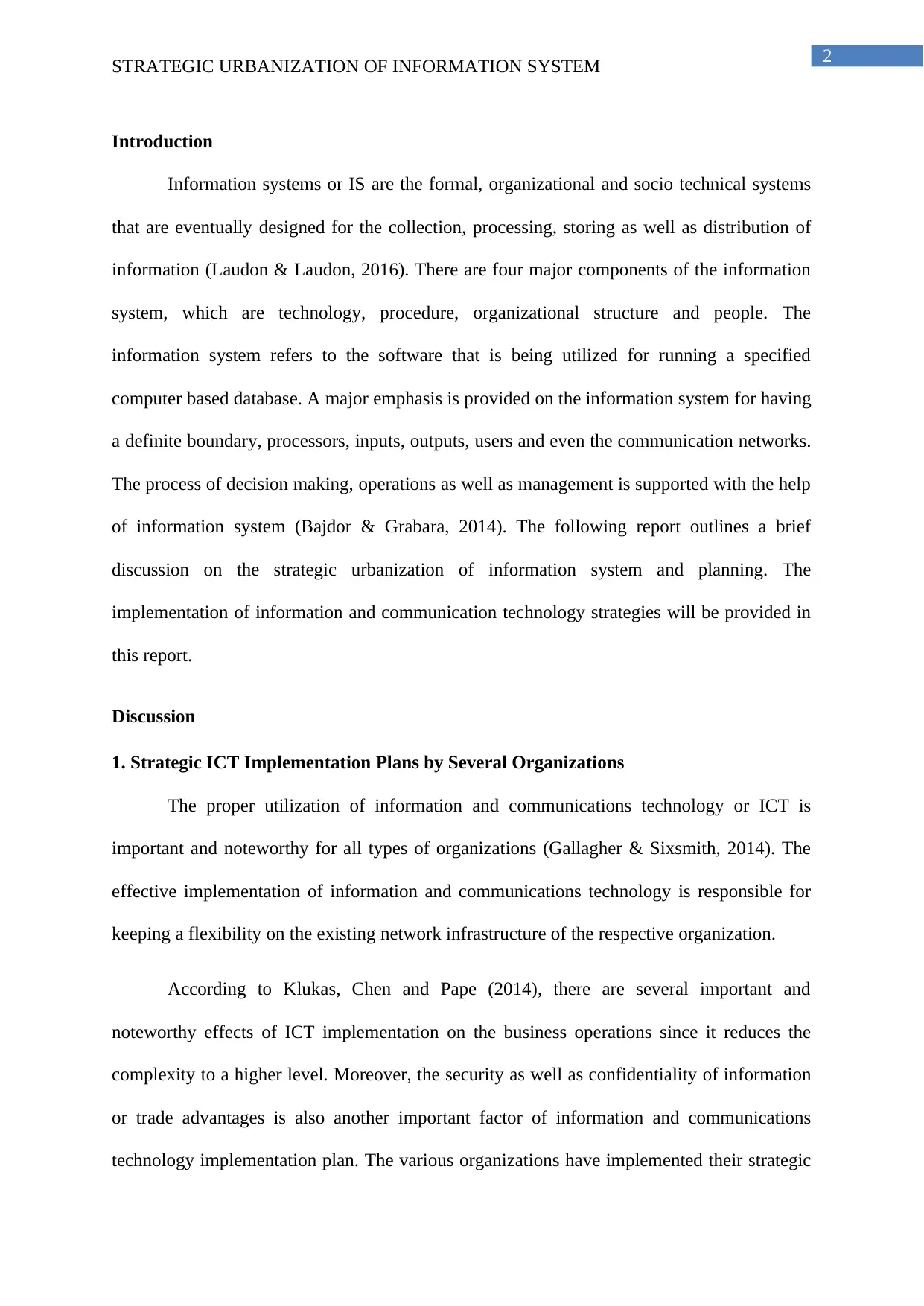
2
STRATEGIC URBANIZATION OF INFORMATION SYSTEM
Introduction
Information systems or IS are the formal, organizational and socio technical systems
that are eventually designed for the collection, processing, storing as well as distribution of
information (Laudon & Laudon, 2016). There are four major components of the information
system, which are technology, procedure, organizational structure and people. The
information system refers to the software that is being utilized for running a specified
computer based database. A major emphasis is provided on the information system for having
a definite boundary, processors, inputs, outputs, users and even the communication networks.
The process of decision making, operations as well as management is supported with the help
of information system (Bajdor & Grabara, 2014). The following report outlines a brief
discussion on the strategic urbanization of information system and planning. The
implementation of information and communication technology strategies will be provided in
this report.
Discussion
1. Strategic ICT Implementation Plans by Several Organizations
The proper utilization of information and communications technology or ICT is
important and noteworthy for all types of organizations (Gallagher & Sixsmith, 2014). The
effective implementation of information and communications technology is responsible for
keeping a flexibility on the existing network infrastructure of the respective organization.
According to Klukas, Chen and Pape (2014), there are several important and
noteworthy effects of ICT implementation on the business operations since it reduces the
complexity to a higher level. Moreover, the security as well as confidentiality of information
or trade advantages is also another important factor of information and communications
technology implementation plan. The various organizations have implemented their strategic
STRATEGIC URBANIZATION OF INFORMATION SYSTEM
Introduction
Information systems or IS are the formal, organizational and socio technical systems
that are eventually designed for the collection, processing, storing as well as distribution of
information (Laudon & Laudon, 2016). There are four major components of the information
system, which are technology, procedure, organizational structure and people. The
information system refers to the software that is being utilized for running a specified
computer based database. A major emphasis is provided on the information system for having
a definite boundary, processors, inputs, outputs, users and even the communication networks.
The process of decision making, operations as well as management is supported with the help
of information system (Bajdor & Grabara, 2014). The following report outlines a brief
discussion on the strategic urbanization of information system and planning. The
implementation of information and communication technology strategies will be provided in
this report.
Discussion
1. Strategic ICT Implementation Plans by Several Organizations
The proper utilization of information and communications technology or ICT is
important and noteworthy for all types of organizations (Gallagher & Sixsmith, 2014). The
effective implementation of information and communications technology is responsible for
keeping a flexibility on the existing network infrastructure of the respective organization.
According to Klukas, Chen and Pape (2014), there are several important and
noteworthy effects of ICT implementation on the business operations since it reduces the
complexity to a higher level. Moreover, the security as well as confidentiality of information
or trade advantages is also another important factor of information and communications
technology implementation plan. The various organizations have implemented their strategic
⊘ This is a preview!⊘
Do you want full access?
Subscribe today to unlock all pages.

Trusted by 1+ million students worldwide
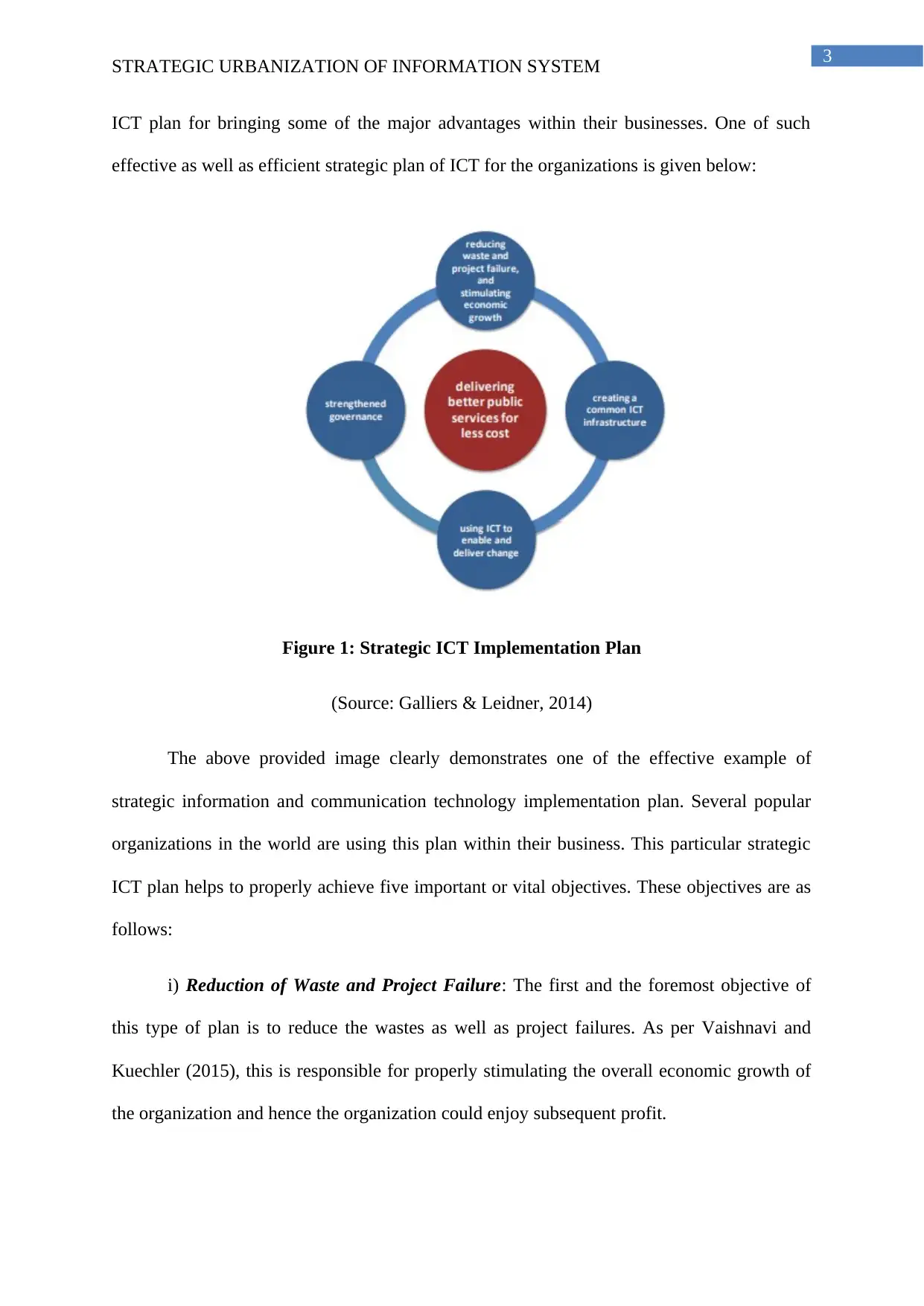
3
STRATEGIC URBANIZATION OF INFORMATION SYSTEM
ICT plan for bringing some of the major advantages within their businesses. One of such
effective as well as efficient strategic plan of ICT for the organizations is given below:
Figure 1: Strategic ICT Implementation Plan
(Source: Galliers & Leidner, 2014)
The above provided image clearly demonstrates one of the effective example of
strategic information and communication technology implementation plan. Several popular
organizations in the world are using this plan within their business. This particular strategic
ICT plan helps to properly achieve five important or vital objectives. These objectives are as
follows:
i) Reduction of Waste and Project Failure: The first and the foremost objective of
this type of plan is to reduce the wastes as well as project failures. As per Vaishnavi and
Kuechler (2015), this is responsible for properly stimulating the overall economic growth of
the organization and hence the organization could enjoy subsequent profit.
STRATEGIC URBANIZATION OF INFORMATION SYSTEM
ICT plan for bringing some of the major advantages within their businesses. One of such
effective as well as efficient strategic plan of ICT for the organizations is given below:
Figure 1: Strategic ICT Implementation Plan
(Source: Galliers & Leidner, 2014)
The above provided image clearly demonstrates one of the effective example of
strategic information and communication technology implementation plan. Several popular
organizations in the world are using this plan within their business. This particular strategic
ICT plan helps to properly achieve five important or vital objectives. These objectives are as
follows:
i) Reduction of Waste and Project Failure: The first and the foremost objective of
this type of plan is to reduce the wastes as well as project failures. As per Vaishnavi and
Kuechler (2015), this is responsible for properly stimulating the overall economic growth of
the organization and hence the organization could enjoy subsequent profit.
Paraphrase This Document
Need a fresh take? Get an instant paraphrase of this document with our AI Paraphraser
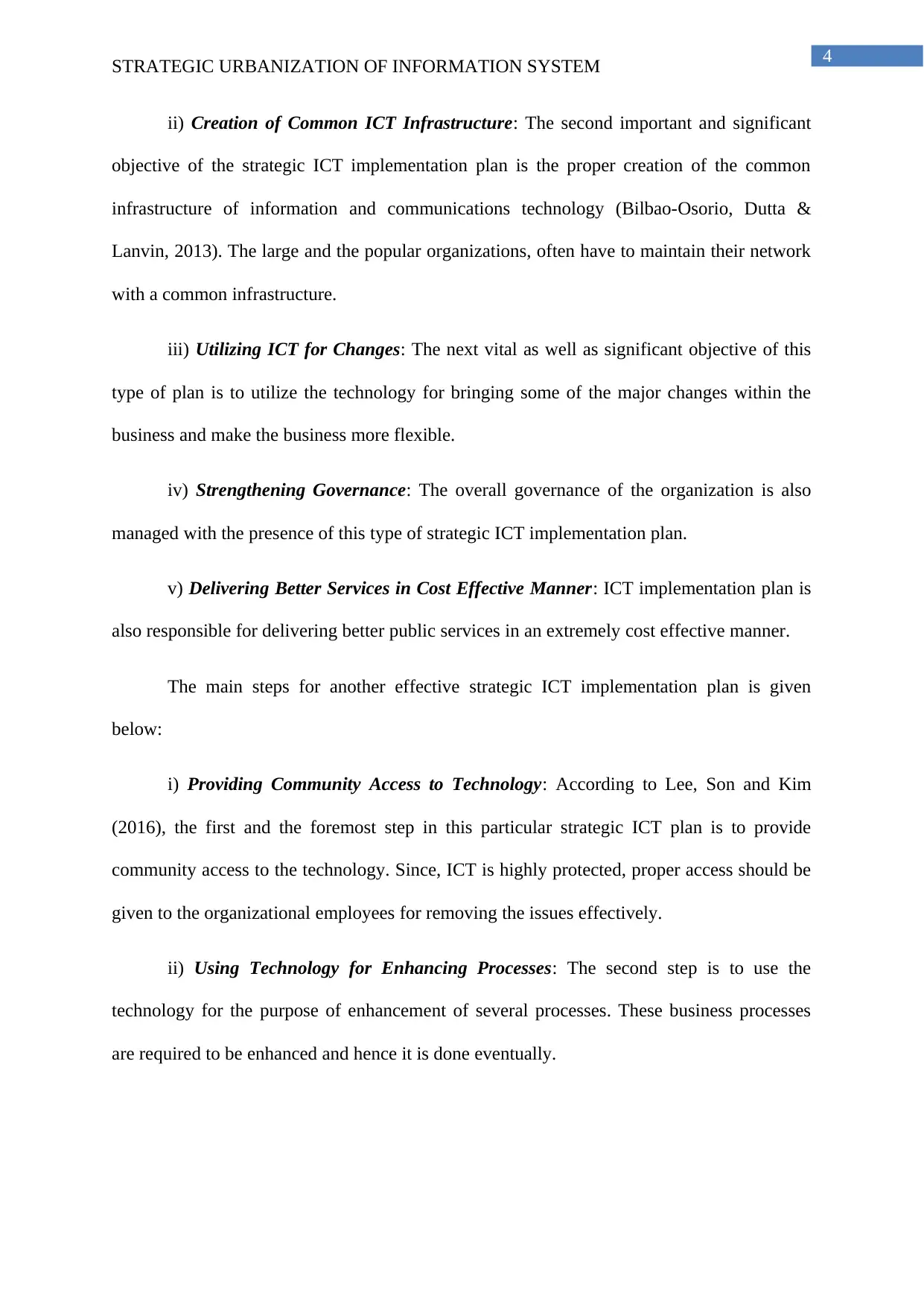
4
STRATEGIC URBANIZATION OF INFORMATION SYSTEM
ii) Creation of Common ICT Infrastructure: The second important and significant
objective of the strategic ICT implementation plan is the proper creation of the common
infrastructure of information and communications technology (Bilbao-Osorio, Dutta &
Lanvin, 2013). The large and the popular organizations, often have to maintain their network
with a common infrastructure.
iii) Utilizing ICT for Changes: The next vital as well as significant objective of this
type of plan is to utilize the technology for bringing some of the major changes within the
business and make the business more flexible.
iv) Strengthening Governance: The overall governance of the organization is also
managed with the presence of this type of strategic ICT implementation plan.
v) Delivering Better Services in Cost Effective Manner: ICT implementation plan is
also responsible for delivering better public services in an extremely cost effective manner.
The main steps for another effective strategic ICT implementation plan is given
below:
i) Providing Community Access to Technology: According to Lee, Son and Kim
(2016), the first and the foremost step in this particular strategic ICT plan is to provide
community access to the technology. Since, ICT is highly protected, proper access should be
given to the organizational employees for removing the issues effectively.
ii) Using Technology for Enhancing Processes: The second step is to use the
technology for the purpose of enhancement of several processes. These business processes
are required to be enhanced and hence it is done eventually.
STRATEGIC URBANIZATION OF INFORMATION SYSTEM
ii) Creation of Common ICT Infrastructure: The second important and significant
objective of the strategic ICT implementation plan is the proper creation of the common
infrastructure of information and communications technology (Bilbao-Osorio, Dutta &
Lanvin, 2013). The large and the popular organizations, often have to maintain their network
with a common infrastructure.
iii) Utilizing ICT for Changes: The next vital as well as significant objective of this
type of plan is to utilize the technology for bringing some of the major changes within the
business and make the business more flexible.
iv) Strengthening Governance: The overall governance of the organization is also
managed with the presence of this type of strategic ICT implementation plan.
v) Delivering Better Services in Cost Effective Manner: ICT implementation plan is
also responsible for delivering better public services in an extremely cost effective manner.
The main steps for another effective strategic ICT implementation plan is given
below:
i) Providing Community Access to Technology: According to Lee, Son and Kim
(2016), the first and the foremost step in this particular strategic ICT plan is to provide
community access to the technology. Since, ICT is highly protected, proper access should be
given to the organizational employees for removing the issues effectively.
ii) Using Technology for Enhancing Processes: The second step is to use the
technology for the purpose of enhancement of several processes. These business processes
are required to be enhanced and hence it is done eventually.
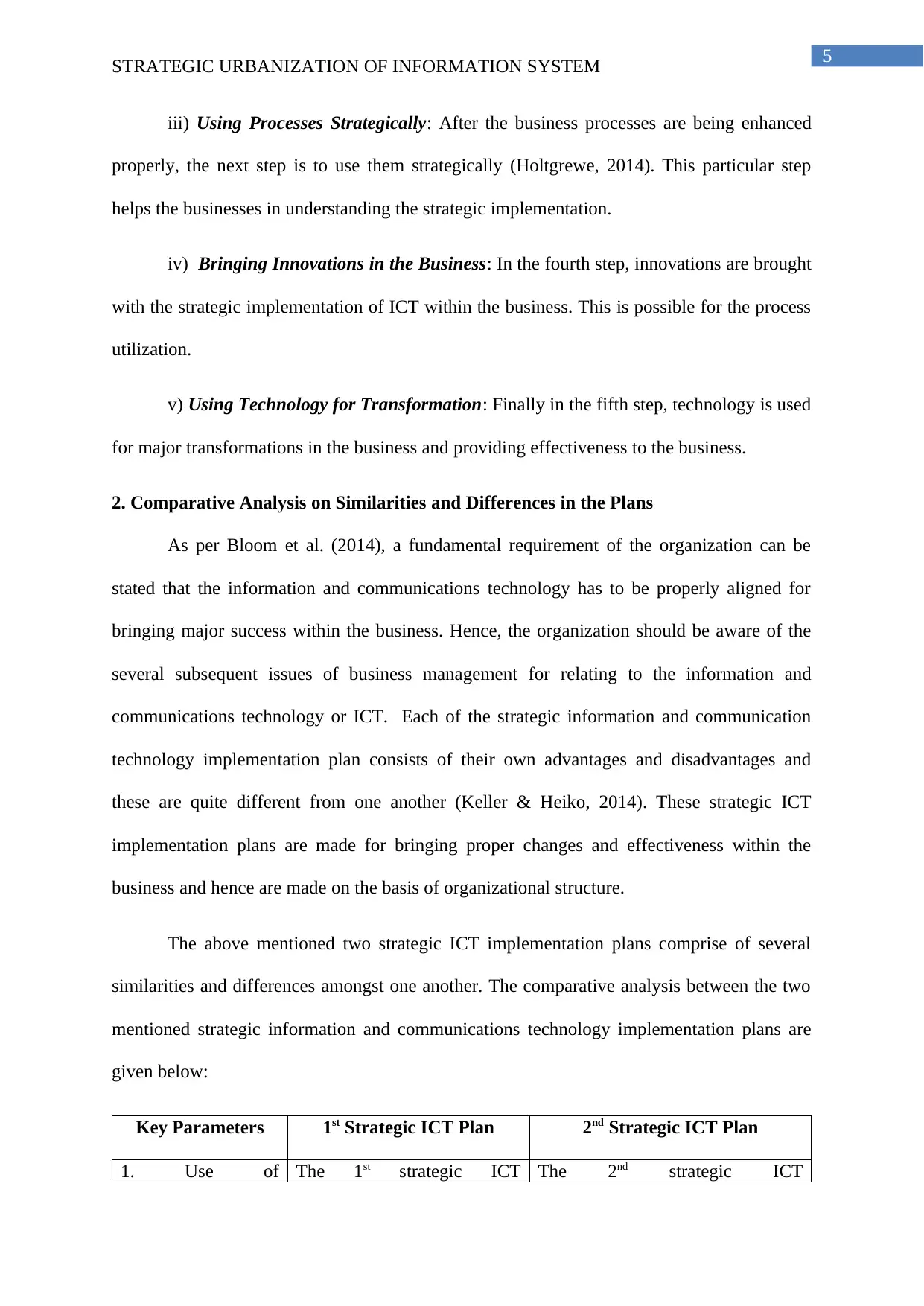
5
STRATEGIC URBANIZATION OF INFORMATION SYSTEM
iii) Using Processes Strategically: After the business processes are being enhanced
properly, the next step is to use them strategically (Holtgrewe, 2014). This particular step
helps the businesses in understanding the strategic implementation.
iv) Bringing Innovations in the Business: In the fourth step, innovations are brought
with the strategic implementation of ICT within the business. This is possible for the process
utilization.
v) Using Technology for Transformation: Finally in the fifth step, technology is used
for major transformations in the business and providing effectiveness to the business.
2. Comparative Analysis on Similarities and Differences in the Plans
As per Bloom et al. (2014), a fundamental requirement of the organization can be
stated that the information and communications technology has to be properly aligned for
bringing major success within the business. Hence, the organization should be aware of the
several subsequent issues of business management for relating to the information and
communications technology or ICT. Each of the strategic information and communication
technology implementation plan consists of their own advantages and disadvantages and
these are quite different from one another (Keller & Heiko, 2014). These strategic ICT
implementation plans are made for bringing proper changes and effectiveness within the
business and hence are made on the basis of organizational structure.
The above mentioned two strategic ICT implementation plans comprise of several
similarities and differences amongst one another. The comparative analysis between the two
mentioned strategic information and communications technology implementation plans are
given below:
Key Parameters 1st Strategic ICT Plan 2nd Strategic ICT Plan
1. Use of The 1st strategic ICT The 2nd strategic ICT
STRATEGIC URBANIZATION OF INFORMATION SYSTEM
iii) Using Processes Strategically: After the business processes are being enhanced
properly, the next step is to use them strategically (Holtgrewe, 2014). This particular step
helps the businesses in understanding the strategic implementation.
iv) Bringing Innovations in the Business: In the fourth step, innovations are brought
with the strategic implementation of ICT within the business. This is possible for the process
utilization.
v) Using Technology for Transformation: Finally in the fifth step, technology is used
for major transformations in the business and providing effectiveness to the business.
2. Comparative Analysis on Similarities and Differences in the Plans
As per Bloom et al. (2014), a fundamental requirement of the organization can be
stated that the information and communications technology has to be properly aligned for
bringing major success within the business. Hence, the organization should be aware of the
several subsequent issues of business management for relating to the information and
communications technology or ICT. Each of the strategic information and communication
technology implementation plan consists of their own advantages and disadvantages and
these are quite different from one another (Keller & Heiko, 2014). These strategic ICT
implementation plans are made for bringing proper changes and effectiveness within the
business and hence are made on the basis of organizational structure.
The above mentioned two strategic ICT implementation plans comprise of several
similarities and differences amongst one another. The comparative analysis between the two
mentioned strategic information and communications technology implementation plans are
given below:
Key Parameters 1st Strategic ICT Plan 2nd Strategic ICT Plan
1. Use of The 1st strategic ICT The 2nd strategic ICT
⊘ This is a preview!⊘
Do you want full access?
Subscribe today to unlock all pages.

Trusted by 1+ million students worldwide
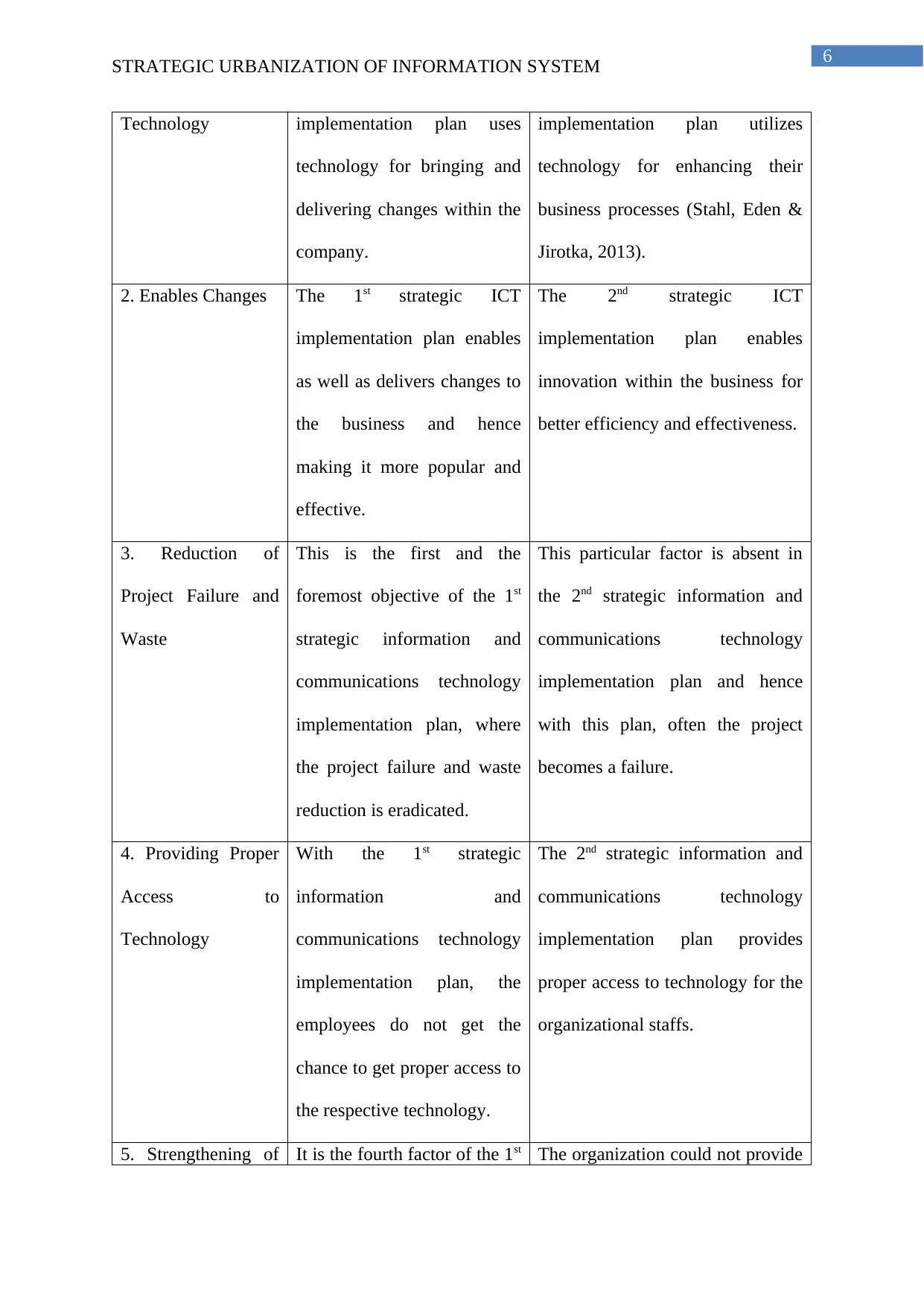
6
STRATEGIC URBANIZATION OF INFORMATION SYSTEM
Technology implementation plan uses
technology for bringing and
delivering changes within the
company.
implementation plan utilizes
technology for enhancing their
business processes (Stahl, Eden &
Jirotka, 2013).
2. Enables Changes The 1st strategic ICT
implementation plan enables
as well as delivers changes to
the business and hence
making it more popular and
effective.
The 2nd strategic ICT
implementation plan enables
innovation within the business for
better efficiency and effectiveness.
3. Reduction of
Project Failure and
Waste
This is the first and the
foremost objective of the 1st
strategic information and
communications technology
implementation plan, where
the project failure and waste
reduction is eradicated.
This particular factor is absent in
the 2nd strategic information and
communications technology
implementation plan and hence
with this plan, often the project
becomes a failure.
4. Providing Proper
Access to
Technology
With the 1st strategic
information and
communications technology
implementation plan, the
employees do not get the
chance to get proper access to
the respective technology.
The 2nd strategic information and
communications technology
implementation plan provides
proper access to technology for the
organizational staffs.
5. Strengthening of It is the fourth factor of the 1st The organization could not provide
STRATEGIC URBANIZATION OF INFORMATION SYSTEM
Technology implementation plan uses
technology for bringing and
delivering changes within the
company.
implementation plan utilizes
technology for enhancing their
business processes (Stahl, Eden &
Jirotka, 2013).
2. Enables Changes The 1st strategic ICT
implementation plan enables
as well as delivers changes to
the business and hence
making it more popular and
effective.
The 2nd strategic ICT
implementation plan enables
innovation within the business for
better efficiency and effectiveness.
3. Reduction of
Project Failure and
Waste
This is the first and the
foremost objective of the 1st
strategic information and
communications technology
implementation plan, where
the project failure and waste
reduction is eradicated.
This particular factor is absent in
the 2nd strategic information and
communications technology
implementation plan and hence
with this plan, often the project
becomes a failure.
4. Providing Proper
Access to
Technology
With the 1st strategic
information and
communications technology
implementation plan, the
employees do not get the
chance to get proper access to
the respective technology.
The 2nd strategic information and
communications technology
implementation plan provides
proper access to technology for the
organizational staffs.
5. Strengthening of It is the fourth factor of the 1st The organization could not provide
Paraphrase This Document
Need a fresh take? Get an instant paraphrase of this document with our AI Paraphraser
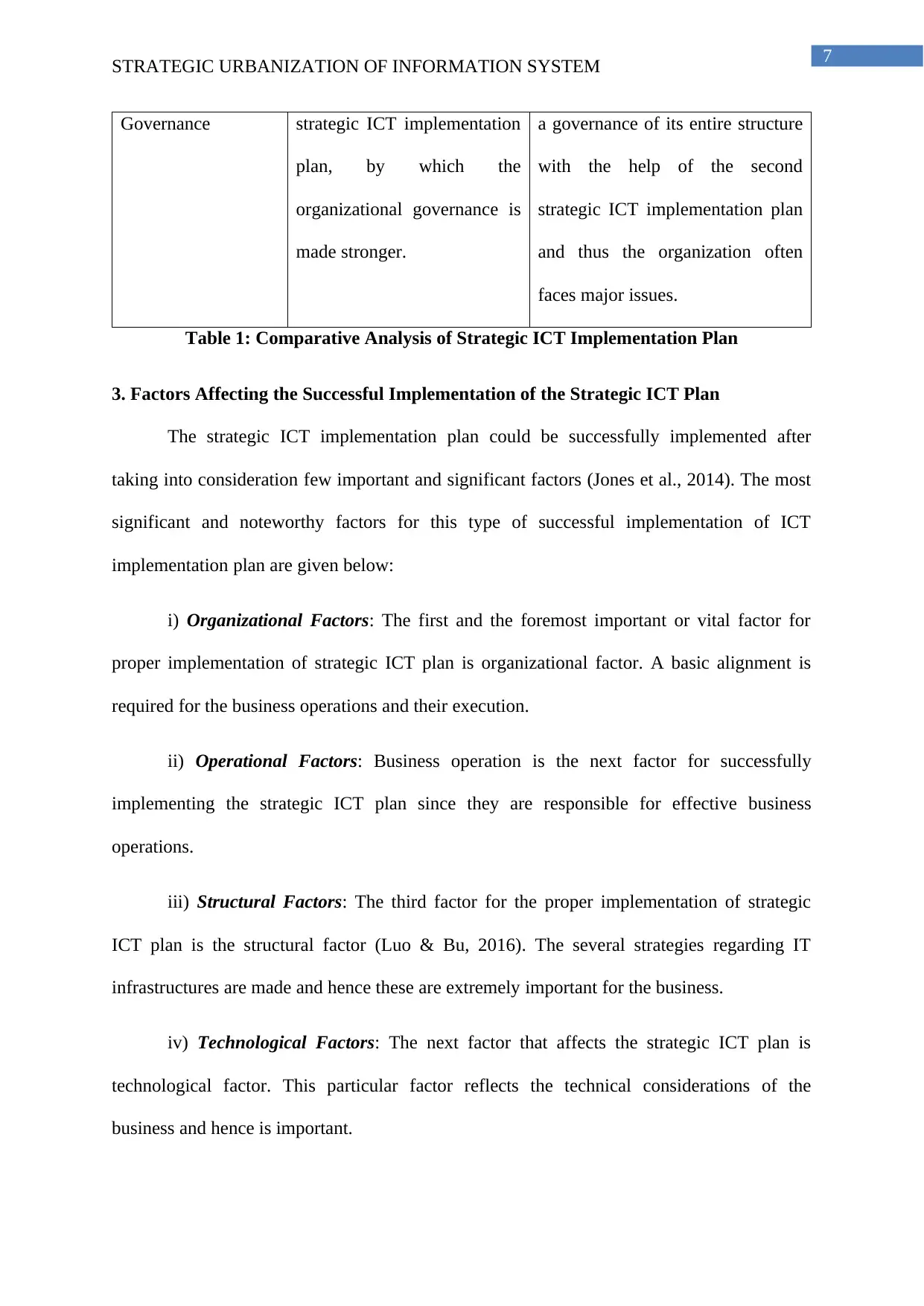
7
STRATEGIC URBANIZATION OF INFORMATION SYSTEM
Governance strategic ICT implementation
plan, by which the
organizational governance is
made stronger.
a governance of its entire structure
with the help of the second
strategic ICT implementation plan
and thus the organization often
faces major issues.
Table 1: Comparative Analysis of Strategic ICT Implementation Plan
3. Factors Affecting the Successful Implementation of the Strategic ICT Plan
The strategic ICT implementation plan could be successfully implemented after
taking into consideration few important and significant factors (Jones et al., 2014). The most
significant and noteworthy factors for this type of successful implementation of ICT
implementation plan are given below:
i) Organizational Factors: The first and the foremost important or vital factor for
proper implementation of strategic ICT plan is organizational factor. A basic alignment is
required for the business operations and their execution.
ii) Operational Factors: Business operation is the next factor for successfully
implementing the strategic ICT plan since they are responsible for effective business
operations.
iii) Structural Factors: The third factor for the proper implementation of strategic
ICT plan is the structural factor (Luo & Bu, 2016). The several strategies regarding IT
infrastructures are made and hence these are extremely important for the business.
iv) Technological Factors: The next factor that affects the strategic ICT plan is
technological factor. This particular factor reflects the technical considerations of the
business and hence is important.
STRATEGIC URBANIZATION OF INFORMATION SYSTEM
Governance strategic ICT implementation
plan, by which the
organizational governance is
made stronger.
a governance of its entire structure
with the help of the second
strategic ICT implementation plan
and thus the organization often
faces major issues.
Table 1: Comparative Analysis of Strategic ICT Implementation Plan
3. Factors Affecting the Successful Implementation of the Strategic ICT Plan
The strategic ICT implementation plan could be successfully implemented after
taking into consideration few important and significant factors (Jones et al., 2014). The most
significant and noteworthy factors for this type of successful implementation of ICT
implementation plan are given below:
i) Organizational Factors: The first and the foremost important or vital factor for
proper implementation of strategic ICT plan is organizational factor. A basic alignment is
required for the business operations and their execution.
ii) Operational Factors: Business operation is the next factor for successfully
implementing the strategic ICT plan since they are responsible for effective business
operations.
iii) Structural Factors: The third factor for the proper implementation of strategic
ICT plan is the structural factor (Luo & Bu, 2016). The several strategies regarding IT
infrastructures are made and hence these are extremely important for the business.
iv) Technological Factors: The next factor that affects the strategic ICT plan is
technological factor. This particular factor reflects the technical considerations of the
business and hence is important.
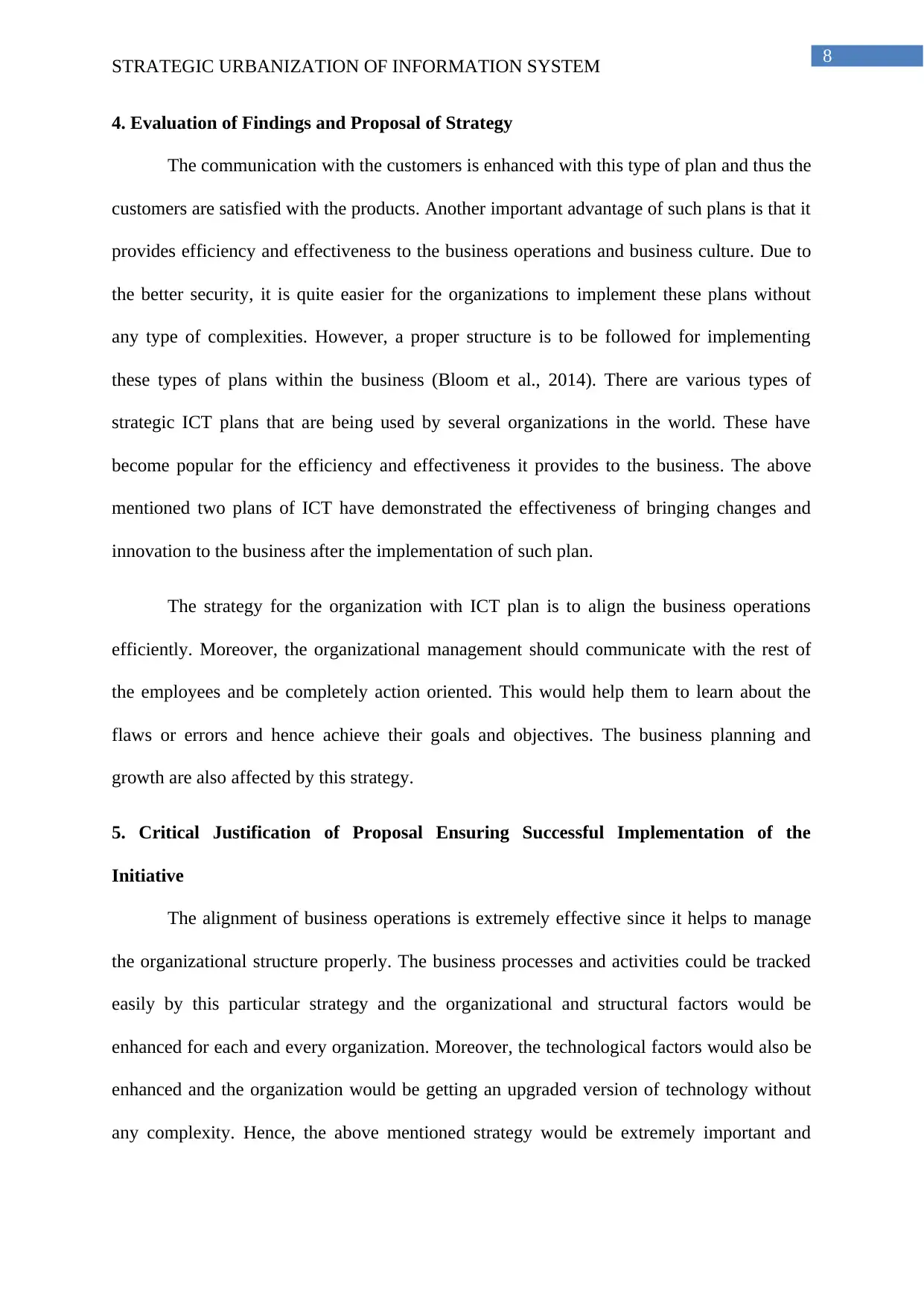
8
STRATEGIC URBANIZATION OF INFORMATION SYSTEM
4. Evaluation of Findings and Proposal of Strategy
The communication with the customers is enhanced with this type of plan and thus the
customers are satisfied with the products. Another important advantage of such plans is that it
provides efficiency and effectiveness to the business operations and business culture. Due to
the better security, it is quite easier for the organizations to implement these plans without
any type of complexities. However, a proper structure is to be followed for implementing
these types of plans within the business (Bloom et al., 2014). There are various types of
strategic ICT plans that are being used by several organizations in the world. These have
become popular for the efficiency and effectiveness it provides to the business. The above
mentioned two plans of ICT have demonstrated the effectiveness of bringing changes and
innovation to the business after the implementation of such plan.
The strategy for the organization with ICT plan is to align the business operations
efficiently. Moreover, the organizational management should communicate with the rest of
the employees and be completely action oriented. This would help them to learn about the
flaws or errors and hence achieve their goals and objectives. The business planning and
growth are also affected by this strategy.
5. Critical Justification of Proposal Ensuring Successful Implementation of the
Initiative
The alignment of business operations is extremely effective since it helps to manage
the organizational structure properly. The business processes and activities could be tracked
easily by this particular strategy and the organizational and structural factors would be
enhanced for each and every organization. Moreover, the technological factors would also be
enhanced and the organization would be getting an upgraded version of technology without
any complexity. Hence, the above mentioned strategy would be extremely important and
STRATEGIC URBANIZATION OF INFORMATION SYSTEM
4. Evaluation of Findings and Proposal of Strategy
The communication with the customers is enhanced with this type of plan and thus the
customers are satisfied with the products. Another important advantage of such plans is that it
provides efficiency and effectiveness to the business operations and business culture. Due to
the better security, it is quite easier for the organizations to implement these plans without
any type of complexities. However, a proper structure is to be followed for implementing
these types of plans within the business (Bloom et al., 2014). There are various types of
strategic ICT plans that are being used by several organizations in the world. These have
become popular for the efficiency and effectiveness it provides to the business. The above
mentioned two plans of ICT have demonstrated the effectiveness of bringing changes and
innovation to the business after the implementation of such plan.
The strategy for the organization with ICT plan is to align the business operations
efficiently. Moreover, the organizational management should communicate with the rest of
the employees and be completely action oriented. This would help them to learn about the
flaws or errors and hence achieve their goals and objectives. The business planning and
growth are also affected by this strategy.
5. Critical Justification of Proposal Ensuring Successful Implementation of the
Initiative
The alignment of business operations is extremely effective since it helps to manage
the organizational structure properly. The business processes and activities could be tracked
easily by this particular strategy and the organizational and structural factors would be
enhanced for each and every organization. Moreover, the technological factors would also be
enhanced and the organization would be getting an upgraded version of technology without
any complexity. Hence, the above mentioned strategy would be extremely important and
⊘ This is a preview!⊘
Do you want full access?
Subscribe today to unlock all pages.

Trusted by 1+ million students worldwide
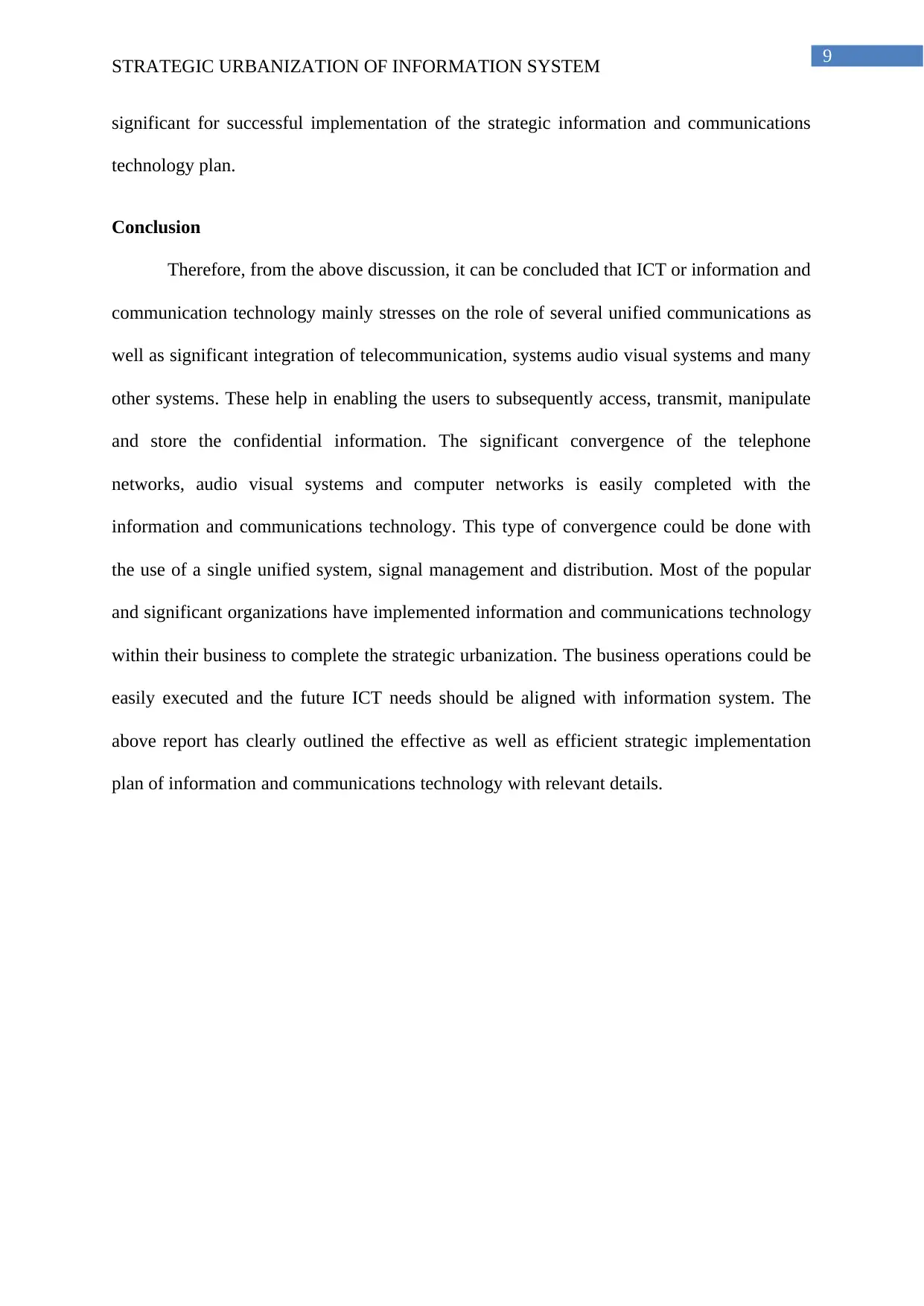
9
STRATEGIC URBANIZATION OF INFORMATION SYSTEM
significant for successful implementation of the strategic information and communications
technology plan.
Conclusion
Therefore, from the above discussion, it can be concluded that ICT or information and
communication technology mainly stresses on the role of several unified communications as
well as significant integration of telecommunication, systems audio visual systems and many
other systems. These help in enabling the users to subsequently access, transmit, manipulate
and store the confidential information. The significant convergence of the telephone
networks, audio visual systems and computer networks is easily completed with the
information and communications technology. This type of convergence could be done with
the use of a single unified system, signal management and distribution. Most of the popular
and significant organizations have implemented information and communications technology
within their business to complete the strategic urbanization. The business operations could be
easily executed and the future ICT needs should be aligned with information system. The
above report has clearly outlined the effective as well as efficient strategic implementation
plan of information and communications technology with relevant details.
STRATEGIC URBANIZATION OF INFORMATION SYSTEM
significant for successful implementation of the strategic information and communications
technology plan.
Conclusion
Therefore, from the above discussion, it can be concluded that ICT or information and
communication technology mainly stresses on the role of several unified communications as
well as significant integration of telecommunication, systems audio visual systems and many
other systems. These help in enabling the users to subsequently access, transmit, manipulate
and store the confidential information. The significant convergence of the telephone
networks, audio visual systems and computer networks is easily completed with the
information and communications technology. This type of convergence could be done with
the use of a single unified system, signal management and distribution. Most of the popular
and significant organizations have implemented information and communications technology
within their business to complete the strategic urbanization. The business operations could be
easily executed and the future ICT needs should be aligned with information system. The
above report has clearly outlined the effective as well as efficient strategic implementation
plan of information and communications technology with relevant details.
Paraphrase This Document
Need a fresh take? Get an instant paraphrase of this document with our AI Paraphraser
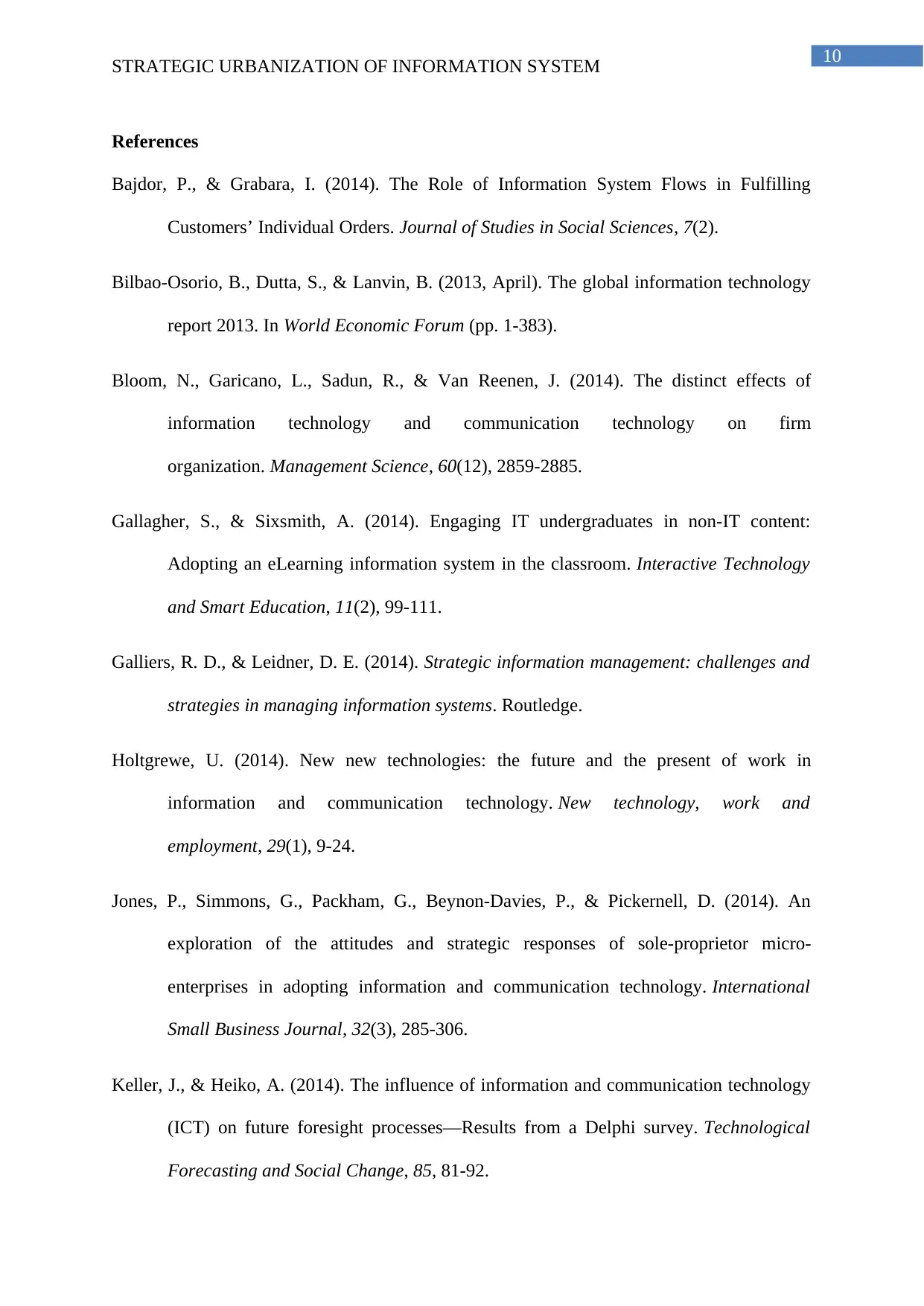
10
STRATEGIC URBANIZATION OF INFORMATION SYSTEM
References
Bajdor, P., & Grabara, I. (2014). The Role of Information System Flows in Fulfilling
Customers’ Individual Orders. Journal of Studies in Social Sciences, 7(2).
Bilbao-Osorio, B., Dutta, S., & Lanvin, B. (2013, April). The global information technology
report 2013. In World Economic Forum (pp. 1-383).
Bloom, N., Garicano, L., Sadun, R., & Van Reenen, J. (2014). The distinct effects of
information technology and communication technology on firm
organization. Management Science, 60(12), 2859-2885.
Gallagher, S., & Sixsmith, A. (2014). Engaging IT undergraduates in non-IT content:
Adopting an eLearning information system in the classroom. Interactive Technology
and Smart Education, 11(2), 99-111.
Galliers, R. D., & Leidner, D. E. (2014). Strategic information management: challenges and
strategies in managing information systems. Routledge.
Holtgrewe, U. (2014). New new technologies: the future and the present of work in
information and communication technology. New technology, work and
employment, 29(1), 9-24.
Jones, P., Simmons, G., Packham, G., Beynon-Davies, P., & Pickernell, D. (2014). An
exploration of the attitudes and strategic responses of sole-proprietor micro-
enterprises in adopting information and communication technology. International
Small Business Journal, 32(3), 285-306.
Keller, J., & Heiko, A. (2014). The influence of information and communication technology
(ICT) on future foresight processes—Results from a Delphi survey. Technological
Forecasting and Social Change, 85, 81-92.
STRATEGIC URBANIZATION OF INFORMATION SYSTEM
References
Bajdor, P., & Grabara, I. (2014). The Role of Information System Flows in Fulfilling
Customers’ Individual Orders. Journal of Studies in Social Sciences, 7(2).
Bilbao-Osorio, B., Dutta, S., & Lanvin, B. (2013, April). The global information technology
report 2013. In World Economic Forum (pp. 1-383).
Bloom, N., Garicano, L., Sadun, R., & Van Reenen, J. (2014). The distinct effects of
information technology and communication technology on firm
organization. Management Science, 60(12), 2859-2885.
Gallagher, S., & Sixsmith, A. (2014). Engaging IT undergraduates in non-IT content:
Adopting an eLearning information system in the classroom. Interactive Technology
and Smart Education, 11(2), 99-111.
Galliers, R. D., & Leidner, D. E. (2014). Strategic information management: challenges and
strategies in managing information systems. Routledge.
Holtgrewe, U. (2014). New new technologies: the future and the present of work in
information and communication technology. New technology, work and
employment, 29(1), 9-24.
Jones, P., Simmons, G., Packham, G., Beynon-Davies, P., & Pickernell, D. (2014). An
exploration of the attitudes and strategic responses of sole-proprietor micro-
enterprises in adopting information and communication technology. International
Small Business Journal, 32(3), 285-306.
Keller, J., & Heiko, A. (2014). The influence of information and communication technology
(ICT) on future foresight processes—Results from a Delphi survey. Technological
Forecasting and Social Change, 85, 81-92.
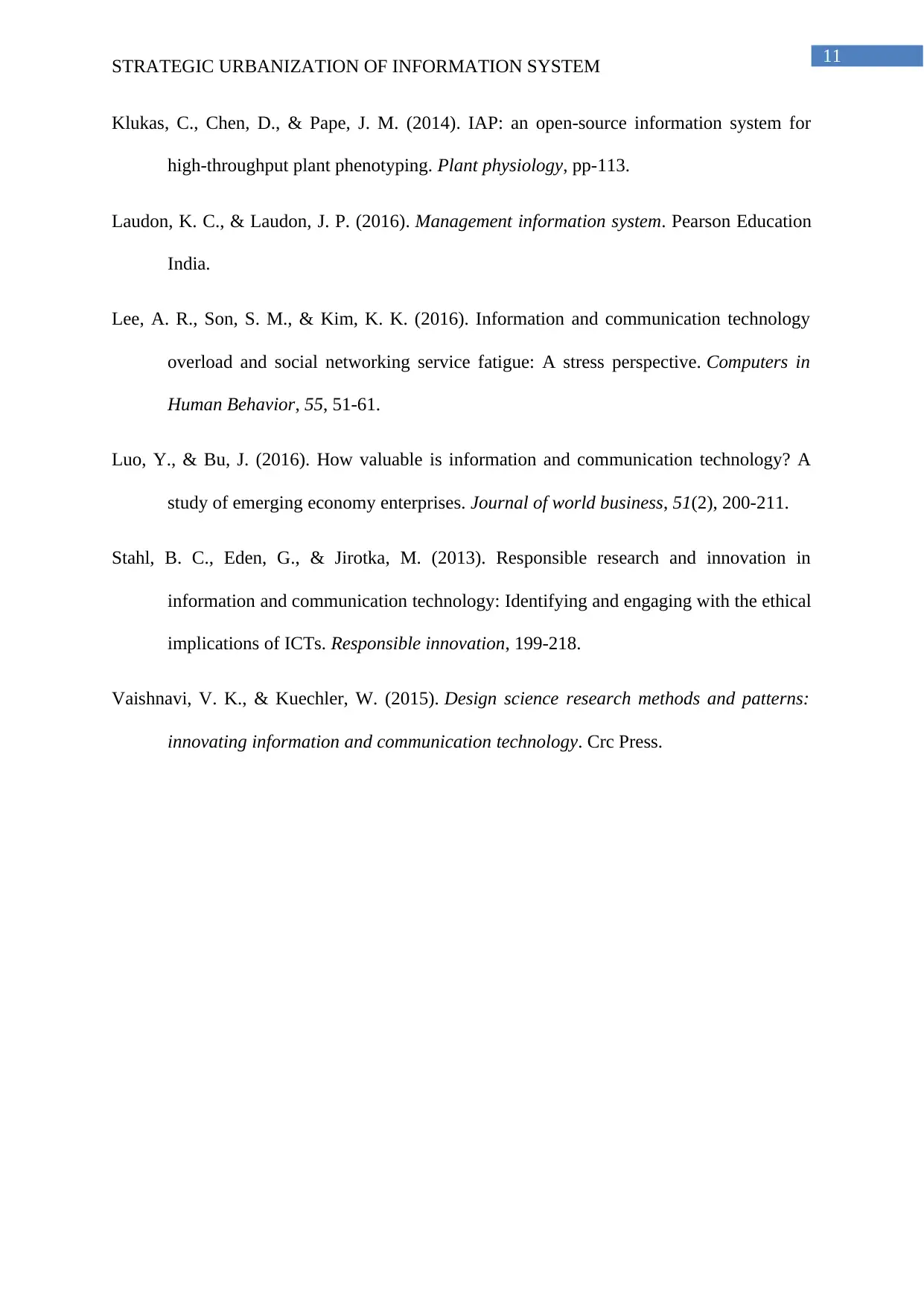
11
STRATEGIC URBANIZATION OF INFORMATION SYSTEM
Klukas, C., Chen, D., & Pape, J. M. (2014). IAP: an open-source information system for
high-throughput plant phenotyping. Plant physiology, pp-113.
Laudon, K. C., & Laudon, J. P. (2016). Management information system. Pearson Education
India.
Lee, A. R., Son, S. M., & Kim, K. K. (2016). Information and communication technology
overload and social networking service fatigue: A stress perspective. Computers in
Human Behavior, 55, 51-61.
Luo, Y., & Bu, J. (2016). How valuable is information and communication technology? A
study of emerging economy enterprises. Journal of world business, 51(2), 200-211.
Stahl, B. C., Eden, G., & Jirotka, M. (2013). Responsible research and innovation in
information and communication technology: Identifying and engaging with the ethical
implications of ICTs. Responsible innovation, 199-218.
Vaishnavi, V. K., & Kuechler, W. (2015). Design science research methods and patterns:
innovating information and communication technology. Crc Press.
STRATEGIC URBANIZATION OF INFORMATION SYSTEM
Klukas, C., Chen, D., & Pape, J. M. (2014). IAP: an open-source information system for
high-throughput plant phenotyping. Plant physiology, pp-113.
Laudon, K. C., & Laudon, J. P. (2016). Management information system. Pearson Education
India.
Lee, A. R., Son, S. M., & Kim, K. K. (2016). Information and communication technology
overload and social networking service fatigue: A stress perspective. Computers in
Human Behavior, 55, 51-61.
Luo, Y., & Bu, J. (2016). How valuable is information and communication technology? A
study of emerging economy enterprises. Journal of world business, 51(2), 200-211.
Stahl, B. C., Eden, G., & Jirotka, M. (2013). Responsible research and innovation in
information and communication technology: Identifying and engaging with the ethical
implications of ICTs. Responsible innovation, 199-218.
Vaishnavi, V. K., & Kuechler, W. (2015). Design science research methods and patterns:
innovating information and communication technology. Crc Press.
⊘ This is a preview!⊘
Do you want full access?
Subscribe today to unlock all pages.

Trusted by 1+ million students worldwide
1 out of 12
Related Documents
Your All-in-One AI-Powered Toolkit for Academic Success.
+13062052269
info@desklib.com
Available 24*7 on WhatsApp / Email
![[object Object]](/_next/static/media/star-bottom.7253800d.svg)
Unlock your academic potential
Copyright © 2020–2025 A2Z Services. All Rights Reserved. Developed and managed by ZUCOL.



